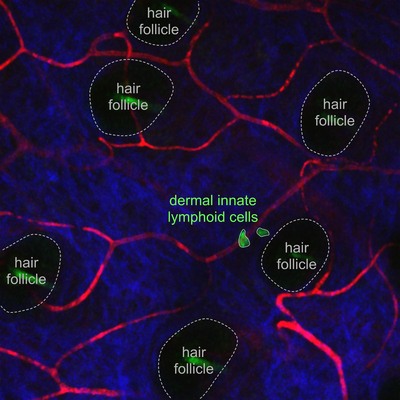A new lymphoid cell

Shedding light on a new type of lymphoid cell that appears to play a role in defence against cutaneous infection and the development of allergies will form the basis of Wolfgang Weninger’s* presentation at the Australasian Society for Immunology meeting.
The basis of Wolfgang Weninger’s work at the Centenary Institute and the Sydney Medical School is the involvement of the immune system in skin diseases.
Recent work Weninger’s team has been pursuing focuses on a subset of innate lymphoid cells called group 2 innate lymphoid cells or ILC2 cells. These cells were identified only a couple of years ago and are known to play a role in immune responses to parasitic infections - for example, helminths - as well as in allergic conditions such as asthma and chronic sinusitis.
“This is a relatively newly discovered cell population that is related to T lymphocytes,” Weninger explained, “but in contrast to T lymphocytes they do not have an antigen or T cell receptor.
“Morphologically they look similar to T cells. The defining feature of the ILC2 cells is that they produce the cytokines IL5 and IL13, which are usually found in T helper cells.”
Type 2 T helper cells are known to produce cytokines including IL-4, IL-5, IL-10, and IL-13. Type 2 cytokines are essential for protection against helminthic infections and also underlie the development of inflammatory allergic conditions, such as dermatitis.
Distinct dermal residents
Weninger’s group recently discovered ILC2 cells in the skin of mice and found that they play an important role during in inflammatory skin reactions.
“We described these cells for the first time in the skin of mice a few months ago,” said Weninger, referring to work that was published in Nature Immunology. “We characterised their development, what cytokines they require and we also managed to visualise them for the first time using microscopy in live mice.”
Using a multiphoton microscopy technique with infrared laser light that enables fluorescent cells to be visualised in intact organs in live mice, Weninger’s team visualised the behaviour of ILC2 cells in real time in intact skin.
“We monitored how these cells migrate within the skin and what other cells they interact with,” said Weninger. “We saw that the ILC2 cells continuously screened the dermis and were communicating with mast cells, which is interesting because mast cells are also implicated in allergies and infections.”
The idea is that the ILC2 cells reside in a normal quiescent state in the dermal layer of the skin, along with a variety of leukocytes such as mast cells and macrophages, and if a worm invades, these cells kick-start inflammation by producing their type 2 cytokines.
“On the flip side, they may also be involved in driving the allergies because the allergies depend on the same cytokines,” he said.
Weninger’s team has also been looking at how to activate the ILC2 cells in the skin and found that they could dramatically increase their numbers by giving mice systemic treatment with complexes of IL-2 and antibody to IL-2.
“When we activate them with IL-2, they not only increase in number, they make much more IL-5 and IL-13, and this leads to spontaneous skin inflammation that looks a bit like eczema,” Weninger said.
Thus, as well as having the potential to initiate type 2 immune responses through the release of these cytokines, ILC2 cells also have the potential to regulate the function of other immune cells residing in the dermis.
Looking at the lungs
Now that they have published their work in skin, Weninger’s team is turning its attention to how ILC2 cells contribute to lung inflammation.
“We found ILC2 cells also play an important role in lung inflammation. We are trying to find out how these cells are activated and what cytokines they produce during lung infections and allergic responses,” Weninger said. “We are interested in how this works and what the consequences of this are for lung pathology.”
From their work in mice, Weninger said they plan to move into humans to see whether a similar pathway exists in humans. ILC2 cells are most likely involved in the pathogenesis of allergic diseases of the lung such as asthma.
They are beginning to look in human skin and in fluid from the lungs, but this work is in its early days.
The immune pathways involved in responses to helminthic infections and allergies have been well studied and the ILC2 cells provide a potential new angle for therapeutic intervention. Although whether they show potential as a new therapeutic is yet to be seen.
“They seem to be very early responders because they sit inside the organs and their function can be increased quite quickly compared to T cells, but they also may be effector cells downstream of the T cell response. So it’s complicated - they may play a role very early on and also late during immune responses.”

Personality influences the expression of our genes
An international research team has used artificial intelligence to show that our personalities...
Pig hearts kept alive outside the body for 24 hours
A major hurdle for human heart transplantation is the limited storage time of the donor heart...
Breakthrough antibiotic for mycobacterial infections
The antibiotic candidate, named COE-PNH2, has been optimised to target Mycobacterium...







